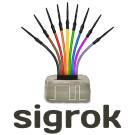Saleae Logic16 support
We're happy to announce that libsigrok now supports the Saleae Logic16 logic analyzer.
This is the successor product of the well-known Saleae Logic (an 8-channel logic analyzer with a max. samplerate of 24MHz and streaming capabilities).

The Logic16 has 16 channels and can sample at rates of up to 100MHz, depending on the number of channels used. If you only need 3 channels you can sample at 100MHz, or 50MHz for 6 channels, or 32MHz for 9 channels, or 16MHz when using all 16 channels.
The property of the Logic16 that makes it really interesting is that it can still stream out the data live over USB (like the Logic) and is thus not limited to any internal buffer size of the logic analyzer itself, while at the same time allowing a samplerate higher than 24MHz. This makes it possible to capture fast signals for longer periods of time (as opposed to just a few milliseconds as is the case for many other devices) which can be very useful in practice.
It also has the advantage that you can switch between two different voltage threshold settings, allowing you to debug either 1.8V / 3.3V systems, or 5V systems.
Of course it still has the same limitations as the Logic, too. Whether the continuous byte stream from the Logic16 can be received quickly enough over USB without missing any bytes depends on various random factors, such as the USB controller in your PC, the OS/kernel version used, the amount of other USB devices connected and how much data those transfer at the same time, etc. etc. But still, for many cases it works well enough to make it quite useful.
Many thanks to Marcus Comstedt for figuring out how the Logic16 protocol works, and for writing the libsigrok driver! He also documented the protocol in the wiki, as well as various firmware internals. We also have some teardown photos, pinouts of the ICs used in the Logic16 and their connections, EEPROM layout and other info in the wiki, if you're interested in this kind of stuff.
The device uses a Cypress FX2 USB chip and a Xilinx Spartan-3A XC3S200A FPGA internally. The first needs a firmware upload when the Logic16 is attached to USB, the latter needs an FPGA bitstream upload upon USB connection (as well as another bitstream upload whenever the voltage threshold setting is changed).
Thanks to Marcus Comstedt again who provided the sigrok-fwextract-saleae-logic16 tool which you can use to extract the FX2 firmware and the two FPGA bitstreams from the vendor software. See the manpage for details.
- Uwe Hermann's blog
- 40539 reads
